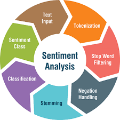Due to their inherent capability in semantic alignment of aspects and their context words, attention mechanism and Convolutional Neural Networks (CNNs) are widely applied for aspect-based sentiment classification. However, these models lack a mechanism to account for relevant syntactical constraints and long-range word dependencies, and hence may mistakenly recognize syntactically irrelevant contextual words as clues for judging aspect sentiment. To tackle this problem, we propose to build a Graph Convolutional Network (GCN) over the dependency tree of a sentence to exploit syntactical information and word dependencies. Based on it, a novel aspect-specific sentiment classification framework is raised. Experiments on three benchmarking collections illustrate that our proposed model has comparable effectiveness to a range of state-of-the-art models, and further demonstrate that both syntactical information and long-range word dependencies are properly captured by the graph convolution structure.
翻译:由于这些模型具有内在能力,可以对各个方面及其上下文词语、注意力机制和进化神经网络进行语义统一,因此广泛应用于基于方位的情绪分类,然而,这些模型缺乏一种机制来说明相关的综合理论限制和长距离单词依赖性,因此可能错误地承认,在判断方面情绪时,相互关联的关联词是一种线索。为了解决这一问题,我们提议建立一个图形革命网络(GCN),对句子的依附树进行图形革命网络(GCN),以利用合成战术信息和单词依赖性。在此基础上,提出了一个新的针对方位的情绪分类框架。对三个基准收集的实验表明,我们提议的模型具有与一系列最新模型相当的效力,并进一步表明,图形组合结构适当捕捉了同步信息和长距离单词依赖性。




